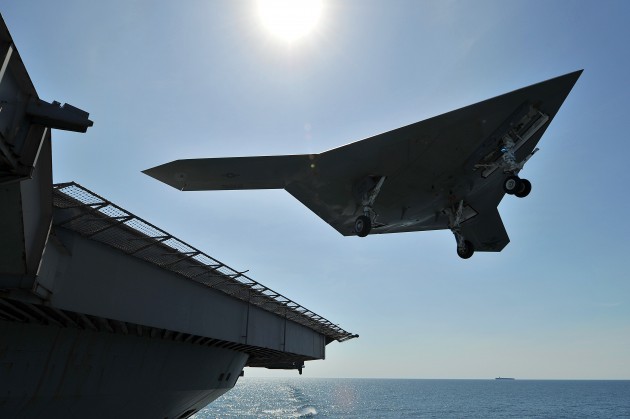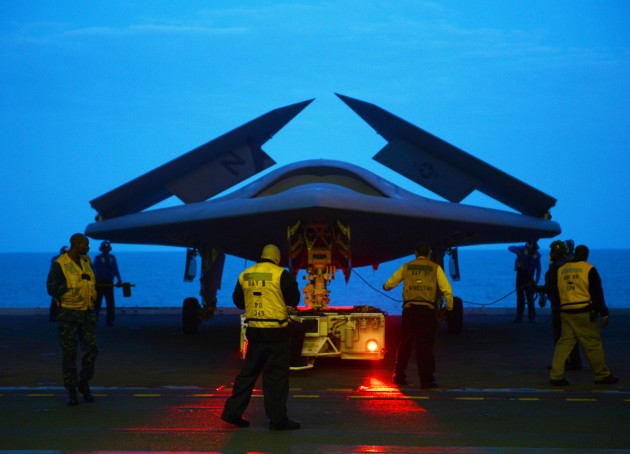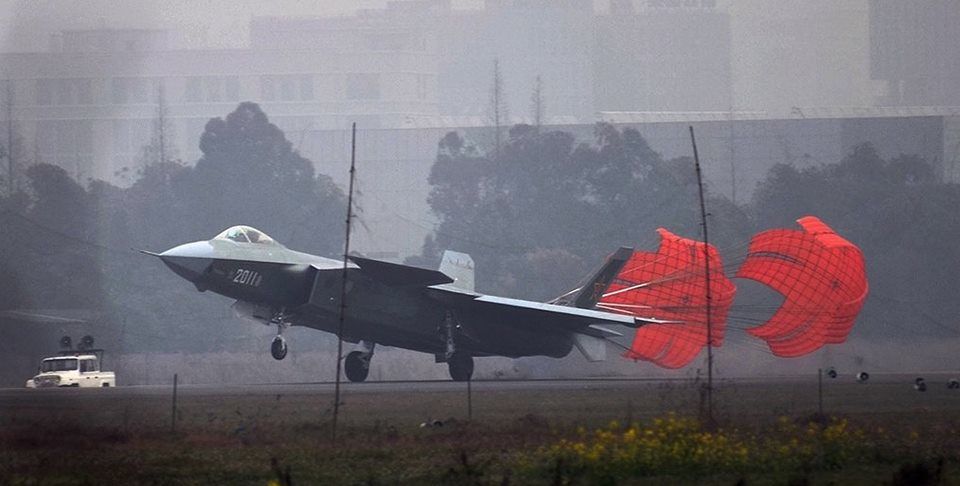Congress Must Protect Tech From DoD Bureaucracy, And Itself: Experts
Posted on

The X-47B drone after its historic first “touch and go.” The revolutionary unmanned aircraft may now be dismantled.
UPDATED w/ Mahnken interview CAPITOL HILL: The US military is not ready for war against Russia or China, leading experts told the House Armed Services Committee this morning. How can Congress help? Champion new technologies that would otherwise drown in the Pentagon bureaucracy, they said, the way it did with the Predator drone and Tomahawk missile in the past.
Admittedly, such long-term investments aren’t the most urgent task for Congress. That would be passing a proper budget instead of stopgap Continuing Resolutions.

Tom Mahnken
“Budgeting through Continuing Resolution has been tremendously corrosive,” Thomas Mahnken, president of the Center for Strategic & Budgetary Assessments (CSBA), told the committee. In particular, because CRs set spending on autopilot at the previous year’s level, with no provision for starting, stopping, or adjusting programs, they essentially freeze any program that’s trying to ramp up. “B-21 (the Air Force’s next generation bomber) is a poster child for how Continuing Resolutions can just corrode a vitally important program.”
UPDATE The most obvious problem is a shortfall in funding, Mahnken told me after the hearing. The Pentagon wanted to grow the B-21 program from 2017 to 2018, so if we end up with a full-year CR, the program will end up about one-third short of what was planned. If Congress eventually does pass the full amount, the program will have just part of the year to spend the additional money, instead of the planned 12 months — a recipe for inefficiency.

B-21 bomber
Less obviously, Mahnken said, the CR prohibits the Pentagon from starting new activities — which is exactly what a growing young program like the B-21 needs to do. “The program is going into the EMD phase (Engineering & Manufacturing Development),” Mahnken said. “You’re starting to ramp up engineering, you’re starting to ramp up manufacturing….Those are new activities….You need to hire people, you need to build stuff. Can you do that under a CR? Probably not.” UPDATE ENDS
But at least the B-21 is in the budget. All too often, the experts said, promising technologies that could generate real military advantage die in the “valley of death” between the laboratory and the end-users in the armed forces. Sometimes it takes congressional intervention to bridge that gap and overcome bureaucratic inertia.

Jim Thomas
“We tend to commit acquisition infanticide,” said Jim Thomas of Telemus Group consulting and the Center for a New American Security (CNAS). Once something becomes an official program of record, he said, all sorts of “special interests” in and out of the Pentagon will fight to protect its funding, but getting into the program in the first place is hard. “This is a critical role that Congress can play … as it’s done historically on a lot of capabilities like Tomahawk cruise missiles in the 1970s and 1980s or Predator UAVs, (which) ran into enormous resistance, and Congress was able to overcome that.”
It’s worth noting that the Predator was originally an “earmark”: a specific spending item requested by a member of Congress and imposed on the Pentagon in legislation. Earmarks — including those for Predator — were widely denounced as corrupt and finally banned in 2011. Since then, some good-government advocates have called for bringing earmarks back, to help bipartisan deal-making and as an essential lubricant to the gridlocked budget process.

Predator drone
Since the 2000s, the Predator has become a mainstay of American power, even an icon, and many other unmanned programs have advanced — but the Pentagon is still doing far less on robotics than it should, said the third expert at the hearing, Paul Scharre of CNAS. The Air Force and Navy in particular are over-invested in short-ranged manned fighters like the F-35, he said, when we need more long-range and/or unmanned platforms that can stealthily penetrate advanced defenses, whether in the air or under the sea.

The Navy’s UCAS demonstrator made history as the first drone to take off and land from an aircraft carrier. Its proposed successor was called UCLASS.
The Need For Failure
Consider the X-47Bs, a pair of experimental drones that proved an unmanned plane could land and takeoff safely from an aircraft carrier — and were promptly mothballed shortly thereafter. The Navy had originally seen the drones as forerunners of a long-range, carrier-launched attack/reconnaissance drone called UCLASS, which was strongly backed by congressional leaders such as former House seapower chairman Randy Forbes. But the Navy later downscaled the ambitious program to an aerial refueling tanker, and it may well dismantle the X-47Bs. It would make much more sense to continue experimenting with the groundbreaking drones, agreed all three experts.

Paul Scharre
But if the Navy did keep the X-47s in the air, said Scharre, “they’d likely get a lot of heat from Congress.” Sure, some members would be happy (although Forbes, the most powerful, lost his primary and is gone), but others would attack it as redundant to other unmanned aircraft efforts, or unnecessary to the Navy’s downgraded drone program.
The problem, said Scharre, is that there’s no advancement without experimentation, but experimentation carries risk of failure. While Silicon Valley accepts that fact and flourishes, the Pentagon does not and struggles. Companies like Google will accept dozens of failures to get one jackpot that pays for all the rest. Congress will overlook dozens of successes to hammer administration witnesses for one failure.
“Congress has to put the right incentives in place,” said Scharre. “If you go to a venture capital firm, they understand that a lot of their investments are going to fail, and that’s what they’re betting on is, they’re going to take risk, and they’re looking for the one that’s going to pay off big. We have the opposite structure.” If the military is going to experiment, he said, “it requires the political top cover.”

Chinese J-20 fighter prototype
Are We Still The Best?
In general, said Mahnken, Congress has come to prize cost efficiency above all else. Unfortunately, he said, innovation is an inherently inefficient process. So are preparations for major war.
“For too long we’ve been focused in the defense industrial base on efficiency, not on really determining what it would take to yield the capabilities we’ll need in war,” said Mahnken. “The biggest risk in a risk averse culture is the risk of not having the capability we need when we need it.”
How big is that risk?
When Rep. Ro Khanna repeated the truism that the US military is the best in the world, Mahnken replied:
“First off, Congressman, and with all due respect, I don’t know whether we have the world’s best military, when it comes to the types of contingencies that I’ve described,” said Mahnken, who’d opened the hearing by describing a Chinese surprise attack with massed precision missiles, cyber weapons, and propaganda. “What basis would we have to judge that? Because the scenario that I laid out would be literally unprecedented.”

German stosstruppen (storm troopers) on the attack in World War I.
“We shouldn’t reassure ourselves falsely that, ‘oh, yes, we have the world’s best military,'” Mahnken said. “We don’t know.”
UPDATE “That’s not being disparaging, that’s not being disrespectful… it is terra incognita,” Mahnken told me after the hearing. He’d once warned me that there were so many unknowns in a future great power clash — that so many technologies, tactics, and organizations would be untested on both sides — that it could easily degenerate into the bloody stalemate like World War I. The US in particular has a long and unhappy history of being unprepared in the first clash of a conflict and learning the hard way how war has changed: First Bull Run, Pearl Harbor and Kasserine Pass, Task Force Smith, Ia Drang.
“Usually, the first battle of the next war is pretty bad,” Mahnken said, “and then the question is how well do you adapt, mobilize, change. And historically we’ve done a good job of that, but that’s sort of cold comfort. You’d rather not have to go through that.” UPDATE ENDS
“The US military is not ready for the threats we face today,” Scharre said bluntly. In one CNAS wargame, a Chinese non-nuclear strike destroyed 200 US aircraft on the ground; wrecked most runways, command posts, and logistics centers; and hit every US ship in harbor in Japan.
“How much time do we have” to fix these shortfalls, asked Rep. Susan Davis.
“These are things that should have been done yesterday and should have been done a decade ago,” said Thomas. Consider the B-21 bomber now in development, he said: “The 2006 Quadrennial Defense Review called for fielding the next generation bomber this year, 2018. We’ve lost close to a decade.”
Subscribe to our newsletter
Promotions, new products and sales. Directly to your inbox.
